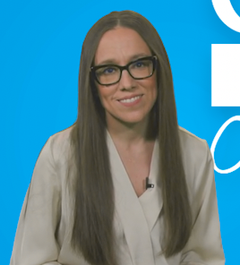
Treatment Considerations for Chronic Lymphocytic Leukemia
Lori A. Leslie, MD, an expert on CLL, talks about factors that influence treatment decisions.
Episodes in this series

Transcript:
Lori A. Leslie, MD: Let’s talk about the types of patient factors we think about when selecting a treatment. Focusing on the front line, for example, we have our BTK [Bruton tyrosine kinase] inhibitors, and those are typically long-term treatments, the way we give it now. You use them as long as they’re working and the patient doesn’t have adverse effects, so patients can be on it for many years. With certain situations, we can decide to add immune therapy IV [intravenously] or not. That might be a patient who starts the drug, they see us 2 weeks later, they see us a month later, and then it’s kind of cruise control, a few checks a year, and they can live their normal life. Then we’ve got some shorter treatments that are based on a BCL2 inhibitor, a different class of drug, for example, venetoclax. That’s what’s called a time-limited treatment, where in the frontline setting, patients only have treatment for a year, and they get the pill and the immune therapy IV. But it’s a different class of drugs where you slowly ramp up the dose, otherwise all the cancer cells can die too quickly and clog up the kidneys and cause this syndrome called TLS [tumor lysis syndrome]. It’s a little more labor intensive.
What type of things do we talk to the patient about convenience-wise that might help them help us decide which type of approach to use? An older person who’s retired and couldn’t care less about the schedule, who doesn’t want to come see us forever, maybe that’s someone who wants time-limited. Or maybe someone who has a busy schedule, and the idea of these frequent visits during the first 1 to 2 months of a ramp-up is just not conducive to their lifestyle, then maybe we’ll recommend a long-term therapy for that patient because it’s a little easier to get started. Maybe there are other medical issues like heart disease, kidney disease, liver disease, anything like that might impact what types of things we would pick for the patient. I think your point to have the patient be vocal in the beginning and not be shy to ask their question and tell us what’s important to them is critical because many of these treatments are done at home. The patients aren’t in our center doing chemotherapy in front of our eyes in the infusion center. They [need to be] compliant with the treatments at home, and take the pills at home. So if it’s not something they’re comfortable with or something that fits into their day-to-day life, that patient is not likely to benefit if they’re not taking the treatment.
Let’s talk a bit about the relapsed/refractory setting. We’ve shifted away from chemotherapy for patients since 2014, but we have patients who were treated earlier who have a later relapse in the second line and beyond, and need a new treatment. How do we decide what to use among an increasing number of options? The most important thing is, what did the patient have before? If someone was on a BTK inhibitor in the first line and that stopped working, and the CLL [chronic lymphocytic leukemia] is coming back while they’re on the BTK inhibitor, then switching to another BTK inhibitor in that same class wouldn’t be an effective approach because that’s not likely to overcome resistance to their treatment. In that case, we would switch to a different type of therapy, like the other pill, venetoclax, for example.
If you had someone who got venetoclax, and that’s usually a 1-year treatment, in the front line and then is relapsing a few years later, we have more options. That type of patient could try venetoclax again, because they were on a treatment holiday when the CLL came back, so that gives us another option. Or you could switch completely, and they could try one of the BTK inhibitors. I would say that flip-flop is probably the most common scenario in the second-line setting. If you had someone who was treated a little further in the past and got chemotherapy, or even some patients got immune therapy, obinutuzumab, in the frontline setting, then you have all the options. You could put them on a BTK inhibitor, you could do the time-limited other group of drugs, a BCL2 inhibitor.
That’s that discussion of what’s important to the patient, what’s going on with their CLL, how is their relapse presenting? We know enough to help fine-tune that for each patient in the relapsed/refractory setting. In the frontline setting, we’ve already talked a bit about looking at different BTK inhibitors compared with chemotherapy. In the relapsed/refractory setting, since we’ve got these 3 BTK inhibitors—ibrutinib, acalabrutinib, and zanubrutinib—all approved, we have some data looking at different BTK inhibitors head-to-head. Those are randomized studies that flip a coin and say either get acalabrutinib or ibrutinib, or another study, ALPINE, where you flip a coin and you get either zanubrutinib or ibrutinib.
Transcript edited for clarity.






